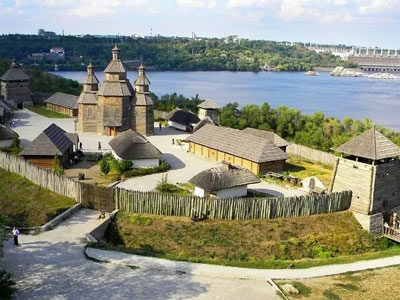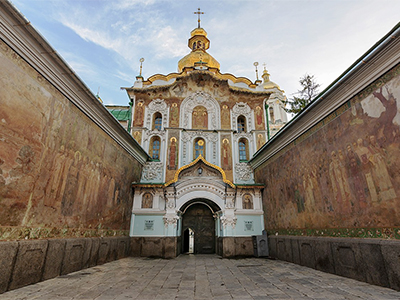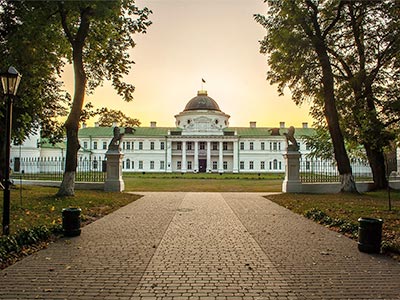 15.10.2023
Khortytsya, witness of the Cossacks’ glory
15.10.2023
Khortytsya, witness of the Cossacks’ gloryThe island of Khortytsya is situated on the Dnipro River, just a stone’s throw from the city of Zaporizhzhya. Talking about the island geographically, one can say that it is the biggest one on the Dnipro River. The island is twelve kilometers long and at some places two and a half kilometers wide. It occupies a territory of almost two and a half thousand hectares.
In the northern part of the island one can see rock outcrops with many caves and grottos. Some of the huge rocks rise to a height of 30 meters above the water. They even have names given to them at various times in the past. Many of these rocks are connected in some way with events of the Cossack times — Duman Rock. Vyshcha Holova (Highest Head) Rock; Chorna (Black) Rock; Sovufyna Rock; Duma Rock, to name but a few. One of the caves, Zmiykova (Snake’s) is said to have been a place the great ancient Greek hero Heracles spent some time in, consorting with a minor goddess and siring three sons.
The central part of the island is flat but not featureless. Ravines, depressions and low hills enliven it, and many of these features also have names — Naumova, Kostina, Hromushyna, Korniyeva, Zmiyivka, to provide some examples. Botanists found there over 600 species of various kinds of plants, many of which are on the list of the endangered species. 50 species of fishes live in the many lakes and babbling brooks of the island, and over 200 species of birds can be spotted in the marshy meadows.
The island’s geographical position greatly contributed to its naturally becoming the crossroads on the trade routes from the north to the south and from the east to the west. Archaeologists unearthed enough evidence to suggest that human settlements appeared on the island in the distant past, at least 35 thousand years ago. In historical times, the first written mention dates from one of the early chronicles, Povist mynulykh lit (Story of Bygone Years) of the late eleventh or early twelfth century: “…and they [grand dukes with their warriors] went down the river, some in boats, others on horseback along the banks, and got around the rapids, and made camp in Protovche and in the Island of Khortytsya.” The dukes mentioned were gathering forces to deal with the imminent invasion of the Polovtsi nomads.
❤️ Your personal English speaking guide in Ukraine.
People of various ethnic backgrounds used to live in Khortytsya — Scythians, early Slavs, Turks and Slavs again. Some of the places’ names in Khortytsya reveal their Turkish origin.
It is known that in the nineteenth century there were over a hundred burial mounds preserved from much earlier times in the island; by now, their number dwindled to about fifty.
The most interesting part of Khortytsya’s history are, of course, the Cossack times of the sixteenth, seventeenth and eighteenth centuries. The first known fortified Cossack settlement in Khortytsya dates from 1556; two centuries later, the Zaporizka Sich Cossack centre was disbanded by the Russian imperial order.
The Museum of History of Zaporizhzhya Cossacks, which was opened in 1983, contains over 30,000 artefacts and other items connected with the history of Khortytsya from the earliest times, through the Cossack times and up to the nineteenth century. Many of the items were donated to the Cossack Museum by other museums of Ukraine.
In 1958, Khortytsya was given a status of a local natural preserve, but it was only in 1993 it was granted the full status of the National Cultural and Historical Preserve.
In 2004, an architectural complex, Zaporizka Sich, began to be built in Khortytsya; the construction began on the Day of Pokrova (religious feast of the Virgin’s Veil) of the Mother of God Virgin Mary the Protectress. The complex which will occupy a territory of three and a half thousand hectares is located in one of the most scenic parts of Khortytsya on its southeast coast. Wooden and other houses, close replicas of houses erected in the Cossack times, are to be built there to reproduce Cossack kureni (dwellings), otaman (military leader) houses, the chancellery, a school, a smithy, a tavern and buildings used for other purposes. A church, Pokrovy Presvyatoyi Bohorodytsi (Church of the Veil of Virgin the Protectress), is planned to be built too. The construction of some of these buildings will be completed by the end of 2006.
Khortytsya is a major tourist attraction, with thousands upon thousands of people from all over Ukraine and abroad coming to see it every year. With the new architectural complex that will recreate the houses of the Cossack times completed and with a new tourist infrastructure established, the number of tourists is likely to grow considerably.
-
 27.02.2024
World of pysanka
Embark on a journey into the captivating world of Pysanka, the Ukrainian...
27.02.2024
World of pysanka
Embark on a journey into the captivating world of Pysanka, the Ukrainian...
-
 29.01.2024
Exploring the Treasures of Kyiv’s Lavra Monastery
In the heart of Kyiv lies the venerable Lavra Monastery, a testament...
29.01.2024
Exploring the Treasures of Kyiv’s Lavra Monastery
In the heart of Kyiv lies the venerable Lavra Monastery, a testament...
-
 13.01.2024
Kachanivka, Eden on Earth
Rich in history, it hosted renowned artists, notably poet Taras Shevchenko.
13.01.2024
Kachanivka, Eden on Earth
Rich in history, it hosted renowned artists, notably poet Taras Shevchenko.

